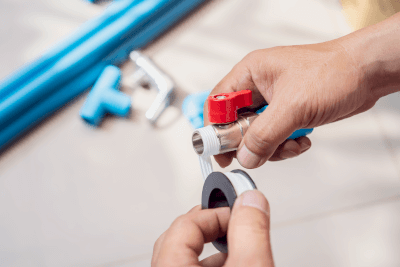What Is a Sealing Tape?

Sealing Tape: Made of PTFE and Highly Resistant to Various Liquids
Sealing tape, a tape used for fittings, is made from PTFE, a type of fluoropolymer. It is resistant to a wide array of liquids, including water, steam, oil, and chemicals. Additionally, sealing tape is thin, soft, and can be easily cut by hand.
Ensure Tight Adherence When Wrapping Sealing Tape
Sealing tape is utilized to fill minor gaps in the threads of joints. It is essential to wrap the tape tightly around the joint for effective sealing. Once removed, the tape cannot be reused due to decreased adhesion.
Uses of Sealing Tapes
Primarily Used to Seal Pipe Fittings
Sealing tapes are widely used for sealing fittings, favored for their chemical resistance, softness, and ease of handling.
Also Used in Research to Prevent Chemical Leakage
In research and development settings, sealing tape is sometimes used to wrap flasks and glass bottles with lids to prevent the leakage and evaporation of chemicals. Due to its excellent chemical resistance, it is suitable for storing various liquids, including organic solvents, acids, and bases.
Characteristics of Sealing Tapes
Stretchable and Adheres Tightly When Pulled
Sealing tapes, thin and soft seals made of PTFE, demonstrate high stability against most acids, bases, and organic solvents. This makes them highly chemical-resistant. When stretched during application, the tape conforms tightly to the surface it’s applied to.
Careful Wrapping Direction Is Essential When Sealing a Joint
When applying sealing tape to the threads of a fitting, it’s crucial to wrap it in the same direction as the thread (usually clockwise). If wrapped in the opposite direction, the tape may unravel when the fitting is turned. It’s advisable to wear gloves or other protective gear to prevent hand injuries from sharp screw edges during application.
Sealing Tape Is Not Reusable Once Removed
Sealing tape is versatile, usable in temperatures ranging from -100 °C to 260 °C. It possesses excellent weather resistance, allowing for long-term use. However, once removed, it cannot be reused due to the loss of stretch and adhesion.